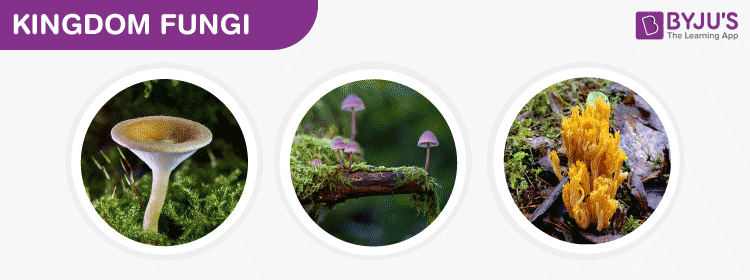Table of Contents
- What is Fungi?
- Structure of Fungi
- Characteristics of Fungi
- Classification of Fungi
- Reproduction in Fungi
- Uses of Fungi
- Examples of Fungi

What is Fungi?
Fungi are eukaryotic organisms that include microorganisms such as yeasts, moulds and mushrooms. These organisms are classified under kingdom fungi.
The organisms found in Kingdom fungi contain a cell wall and are omnipresent. They are classified as heterotrophs among the living organisms.

Kingdom Fungi
To name a few – the appearance of black spots on bread left outside for some days, the mushrooms and the yeast cells, which are commonly used for the production of beer and bread are also fungi. They are also found in most skin infections and other fungal diseases.
If we observe carefully, all the examples that we cited involve moist conditions. Thus, we can say that fungi usually grow in places which are moist and warm enough to support them.
Let us have a detailed overview of the structure, classification and characteristics of fungi.
Also Read: Kingdom Animalia
Structure of Fungi

The structure of fungi can be explained in the following points:
- Almost all the fungi have a filamentous structure except the yeast cells.
- They can be either single-celled or multicellular organisms.
- Fungi consist of long thread-like structures known as hyphae. These hyphae together form a mesh-like structure called mycelium.
- Fungi possess a cell wall which is made up of chitin and polysaccharides.
- The cell wall comprises a protoplast, which is differentiated into other cell parts such as cell membrane, cytoplasm, cell organelles and nuclei.
- The nucleus is dense, clear, with chromatin threads. The nucleus is surrounded by a nuclear membrane.
Also Refer: Fungal Cell Wall
Characteristics of Fungi
Following are the important characteristics of fungi:
- Fungi are eukaryotic, non-vascular, non-motile and heterotrophic organisms.
- They may be unicellular or filamentous.
- They reproduce by means of spores.
- Fungi exhibit the phenomenon of alternation of generation.
- Fungi lack chlorophyll and hence cannot perform photosynthesis.
- Fungi store their food in the form of starch.
- Biosynthesis of chitin occurs in fungi.
- The nuclei of the fungi are very small.
- The fungi have no embryonic stage. They develop from the spores.
- The mode of reproduction is sexual or asexual.
- Some fungi are parasitic and can infect the host.
- Fungi produce a chemical called pheromone which leads to sexual reproduction in fungi.
- Examples include mushrooms, moulds and yeast.
Also Read: Five Kingdom Classification
Classification of Fungi
Kingdom Fungi are classified based on different modes. The different classification of fungi is as follows:
Based on Mode of nutrition
On the basis of nutrition, kingdom fungi can be classified into 3 groups.
- Saprophytic – The fungi obtain their nutrition by feeding on dead organic substances. Examples: Rhizopus, Penicillium and Aspergillus.
- Parasitic – The fungi obtain their nutrition by living on other living organisms (plants or animals) and absorb nutrients from their host. Examples: Taphrina and Puccinia.
- Symbiotic – These fungi live by having an interdependent relationship with other species in which both are mutually benefited. Examples: Lichens and mycorrhiza. Lichens are the symbiotic association between algae and fungi. Here both algae and fungi are mutually benefited as fungi provide shelter for algae and in reverse algae synthesis carbohydrates for fungi. Mycorrhiza is the symbiotic association present between fungi and plants. Fungi improve nutrient uptake by plants, whereas, plants provides organic molecules like sugar to the fungus.
Based on Spore Formation
Kingdom Fungi are classified into the following based on the formation of spores:
- Zygomycetes – These are formed by the fusion of two different cells. The sexual spores are known as zygospores, while the asexual spores are known as sporangiospores. The hyphae are without the septa. Example – Mucor.
- Ascomycetes – They are also called sac fungi. They can be coprophilous, decomposers, parasitic or saprophytic. The sexual spores are called ascospores. Asexual reproduction occurs by conidiospores. Example – Saccharomyces.
- Basidiomycetes – Mushrooms are the most commonly found basidiomycetes and mostly live as parasites. Sexual reproduction occurs by basidiospores. Asexual reproduction occurs by conidia, budding or fragmentation. Example- Agaricus.
- Deuteromycetes – They are otherwise called imperfect fungi as they do not follow the regular reproduction cycle as the other fungi. They do not reproduce sexually. Asexual reproduction occurs by conidia. Example – Trichoderma.
Also Read: Difference Between Algae And Fungi
Reproduction in Fungi

Reproduction in Fungi
Reproduction in fungi is both by sexual and asexual means. The sexual mode of reproduction is referred to as teleomorph and the asexual mode of reproduction is referred to as anamorph.
Vegetative reproduction in fungi –This takes place by budding, fission and fragmentation.
Asexual reproduction – This takes place with the help of spores called conidia or zoospores, or sporangiospores.
Sexual reproduction – This occurs by ascospores, basidiospores, and oospores.
The conventional mode of sexual reproduction is not always observed in the kingdom Fungi. In some fungi, the fusion of two haploid hyphae does not result in the formation of a diploid cell. In such cases, there appears an intermediate stage called the dikaryophase. This stage is followed by the formation of diploid cells.
Also Read: Kingdom Monera, Protista and Fungi
Recommended Video:

Uses of Fungi
Fungi are one of the most important groups of organisms on the planet as they play a vital role in the biosphere and have great economic importance on account of both their benefits and harmful effects.
Following are some of the important uses of fungi:
- Recycling – They play a major role in recycling the dead and decayed matter.
- Food – The mushrooms species which are cultured are edible and are used as food by humans.
- Medicines – There are many fungi that are used to produce antibiotics and to control diseases in humans and animals. Penicillin antibiotic is derived from a common fungus called Penicillium.
- Biocontrol Agents – Fungi are involved in exploiting insects, other small worms and help in controlling pests. Spores of fungi are used as a spray on crops.
- Food spoilage – Fungi play a major role in recycling organic material and are also responsible for major spoilage and economic losses of stored food.
Examples of Fungi
Following are the common examples of fungi:
- Yeast
- Mushrooms
- Moulds
- Truffles
Also Read: Plant Kingdom
To know more about what is fungi, its structure, characteristics of fungi, classification of fungi, different examples of fungi and other concepts related to kingdom fungi, keep visiting BYJU’S website or download the BYJU’S app for further reference.

I love this note
l take this opportunity to than you for your good notes.
This is really helpful and educative but i think there should be some details on the phyla with examples .also the mycorrhiza ,there should be the name of the organism involved in that relationship
I really love and appreciate the information given on this kingdom
Good work
very good work thank
you
Good and well summarized notes thanks
It’s really helpful
Thanks, I understand a lot of about kingdom fungi, what is fungi ,structure of fungi, characteristics of fungi, classification of fungi, thanks a lot
Thank you this was the better answer
THANK YOU TEAM BYJU’S FOR PROVIDING SUCH BEAUTIFUL AND SELF – EXPLANATORY NOTES ON FUNGI.
Very Helpful Notes but they should add more notes.
Superb notes
Because it only cleared my doubt regarding spores
where is the example of each classes of fungi?
I agree with Prajyot Lashkare because this has a lot of information But I feel like it would be a lot more help if you put more.
This is awesome.
thank you very much
Very nice notes keep it up
It’s really helpful
Very informative, thanks
this note help me in many ways . my work is easy from this note . very good
Thank you for this detailed explanation and brief points. It was really helpful.
Thank you for the detailed explanation and brief points. It was very helpful. Kindly provide us answers in point wise .